Our editors independently select these products. Making a purchase through our links may earn Well+Good a commission
We’ve Reached the Golden Age of Treating Hyperpigmentation, and Our Routines Are All the Better for It
Managing discoloration has historically been difficult, but these innovative new hyperpigmentation treatments are changing the game.
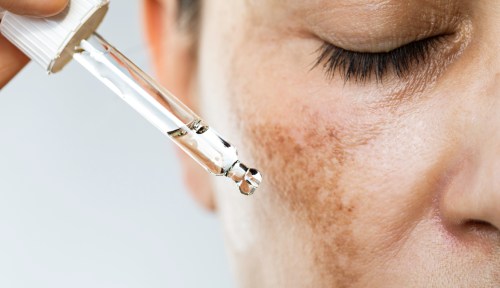
Hyperpigmentation is among the most common skin concerns people deal with—it affects up to 5 million people in the US1—yet it is also notoriously one of the hardest to treat. Because of the difficulty associated with finding effective at-home solutions, doing away with dark spots has historically meant relying on in-office treatments like lasers and chemical peels—especially for those with darker skin tones. But now, that’s started to change.
Recently, the beauty industry has seen an influx of new technology exclusively dedicated to fading discoloration. Brands like Lion Pose, Mother Science, RescueMD, and PillowtalkDerm have established themselves as leaders in innovation, placing us squarely in the Golden Age of treating hyperpigmentation. For the first time (maybe ever), evenly-toned skin is within our reach—and our routines are all the better for it.
What is hyperpigmentation?
Hyperpigmentation is an umbrella term that describes a number of different types of skin discoloration including post-inflammatory pigmentation (AKA acne scarring), sun spots, and melasma. It occurs when the melanocytes in your skin (the cells that are responsible for pigment) go into overdrive and churn out extra melanin, which can happen as a result of a number of factors including sun exposure, hormones, and inflammation.
While anyone can experience hyperpigmentation, it tends to be more common for those with darker complexions because their melanocytes are more sensitive to various triggers. “People with deeper skin tones naturally have a higher level of melanin, the pigment responsible for skin coloration,” says Michael Suzman, MD, board-certified plastic surgeon and founder of RescueMD. “If there’s an excess of melanin present, it creates the perfect environment for dark spots to appear.”
There are two main types of hyperpigmentation: Localized, which shows up in small patches (like acne scarring and sun spots); and diffused, which tends to cover a larger area (like melasma). Depending on your skin’s condition and the underlying cause of the hyperpigmentation, some of these patches may naturally fade over time, while others might require weeks or even months of attention and care to resolve.
How hyperpigmentation has historically been treated
“Hyperpigmentation is one of the most difficult skin conditions to treat, as the damage tends to occur both superficially as well as in the deeper layers of the skin,” says Dr. Suzman. “Because of this, many treatments can be quite destructive to the skin in order to reach the deeper layers.”
Though there have long been ingredients on the market that can help with hyperpigmentation, none has proven to be perfect (except, of course, sunscreen, which can prevent it from happening in the first place). Take vitamin C—which has long been touted as a cure-all for discoloration—for example. “Framing vitamin C it as the ultimate solution to dark spots is absolutely false,” says Shereene Idriss, MD, founder of Idriss Dermatology and PillowtalkDerm Skincare. She explains that while vitamin C can help with brightening, you need to pair it with other ingredients like alpha arbutin, kojic acid, licorice root, and niacinamide, to see significant effects on discoloration. “When you’re dealing with hyperpigmentation and melasma, it’s not a single-ingredient treatment plan. You have to target the pigment pathway and how pigment is produced at various different checkpoints, which require a combination of ingredients,” she explains.
Retinol has also gotten some glory for treating hyperpigmentation because it “increases cell turnover, which can help reduce the appearance of marks and spots,” says Ellie Copsey, product development manager at Isle of Paradise, which recently launched a line of body-care products that tackle hyperpigmentation from the neck down. However, “It’s well known that it can make the skin more sensitive, which can increase the risk of further UV-induced hyperpigmentation,” she adds.
And hydroquinone, a bleaching agent that was once the most popular ingredient for hyperpigmentation, has fallen out of favor in recent years due to the negative side effects that come along with using it. “Prolonged and excessive use of it can lead to a condition called ochronosis, which involves skin discoloration and thickening,” explains Dr. Idriss. Though the ingredient is still available via prescription, over-the-counter sales of the controversial active were banned in 2020 as part of the CARES Act.
Finding effective OTC hyperpigmentation treatments has been particularly challenging for those with deeper skin tones. “There’s become an overarching awareness of the lack of clinical testing and research being done on products for people of color,” says Madhu Punjabi, the co-founder and CEO of Lion Pose. According to the National Library of Medicine2, only 3 percent of skin-care physicians are Black and dermatology textbooks rarely contain images of conditions on minority skin tones, which doesn’t add up because “in America, over 50 percent of people with medium-to-dark skin tones suffer from hyperpigmentation” she says. But thanks to a handful of new launches (just last week, Vaseline released its Black Radiance Even Tone Nourishing Body Lotion to address discoloration in Black and Brown Skin) there are more options for everyone than ever before.
Meet the brands leading innovation in hyperpigmentation treatments
The latest innovations in the skin-tone evening space deserve our recognition because they’re tackling hyperpigmentation in thoughtful and inclusive ways. They’re utilizing topical ingredients that are safe enough for all skin tones to use every day, and support skin repair more organically than their predecessors.
RescueMD
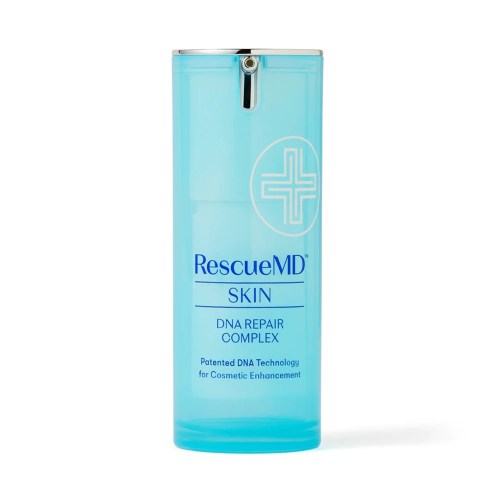
RescueMD, DNA Repair Complex — $88.00
RescueMD’s DNA Repair Complex ($88) addresses skin pigmentation by targeting the skin injury at a cellular level. “The idea is that excess melanin production, scarring, redness, or texture changes can be a response to inflammation and cellular stress or injury,” explains Dr. Suzman.
The hero here is a proprietary ingredient called Lapachol, which slows the skin’s healing process and contributes to more efficacious healing. “It tackles skin damage at the source by aiding in the skin’s own DNA repair,” says Dr. Suzman. He adds that “helping control skin injury and stress with Lapachol can help the cells behave more normally.” The ingredient works alongside sunflower-based lipids and currant seed extract, which fight cellular damage the inflammatory response caused by free radicals and other injuries. According to Dr. Suzman, this combination of ingredients will prevent melanocytes from being triggered, lessening the likelihood of hyperpigmentation.
Mother Science
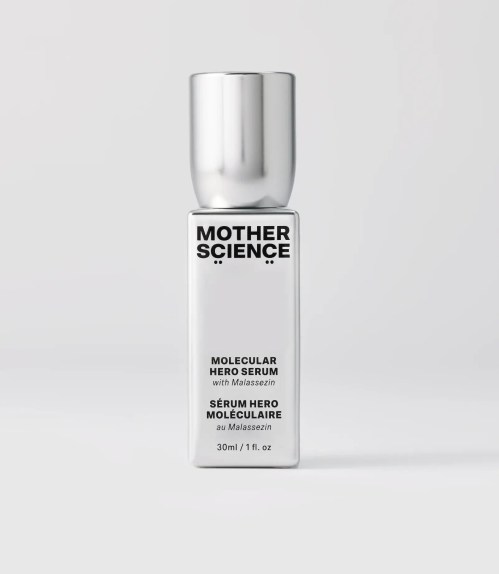
Mother Sciene, Molecular Hero Serum — $89.00
To combat hyperpigmentation, Mother Science has harnessed the power of a new antioxidant called malessezin, a naturally-occurring component of our skin microbiomes (fun fact: it comes from malassezia furfur, the yeast that causes dandruff) that regulates melanin production.
“Most hyperpigmentation products on the market function as tyrosinase inhibitors, meaning that they fight discoloration by reducing melanin production,” explains Pearl Grimes, MD, the brand’s chief dermatologist. “Malassezin, however visibly fades hyperpigmentation in three ways: reducing excess melanin production, decreasing melanin transport to the upper layers of skin, and minimizing melanin transfer to the keratinocyte skin cells.”
First, the ingredient slows the excess production of melanin. Then, it slows the transport of that melanin to the uppermost layer of the skin, which makes discoloration less likely to show up on the surface. Finally, “it slows the transfer from the melanocyte, which is the highway-like structure that melanin travels up through, to the keratinocyte, the top layer of your skin cells,” explains Ann Marie Einziger, the brand’s founder.
PillowtalkDerm
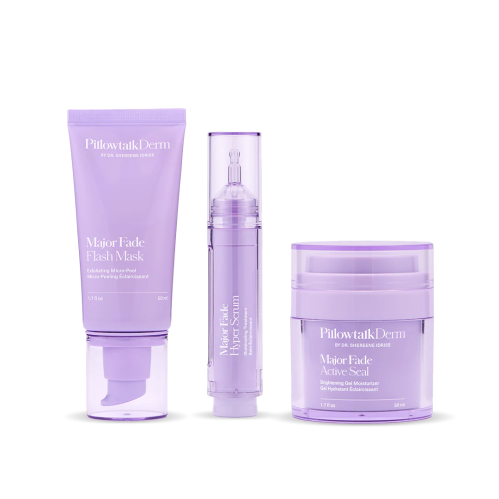
PillowtalkDerm, Major Fade Solution System — $165.00
Dr. Idriss’s goal with PillowtalkDerm was to help patients treat hyperpigmentation more quickly than they could with other over-the-counter interventions. Through research, she discovered that the best way to fade discoloration was with a multi-ingredient, multi-factorial approach that addresses every point along the pigment pathway: When the melanocyte cells make pigmentation (aka melanin), when that melanin gets put into little parcels called melanosomes, and finally when those melanosomes are distributed into our keratinocytes (aka skin cells), which determines how the pigment appears on our skin.
The brand’s three-step system—which includes a mask, serum, and moisturizer—hits all of these checkpoints with actives like vitamin C, alpha arbutin, and a laundry list of exfoliating acids (glycolic, lactic, kojic, and tranexamic). “If you look at the products, each one hits it at a different level, and all of the ingredients target different points throughout the pathway,” says Dr. Idriss. “The Flash Mask targets the melanocytes and also helps on the superficial level by getting rid of all of the dead skin cells living on the top of your skin, the serum minimizes melanin production, and the moisturizer works to slow down how [the melanin] is spread throughout your skin cells. Each one on its own is a hero product, but the trio is a powerhouse.”
The synergy of the system helps to fade discoloration in eight weeks, whereas most traditional methods take 12 to get the job done.
Lion Pose
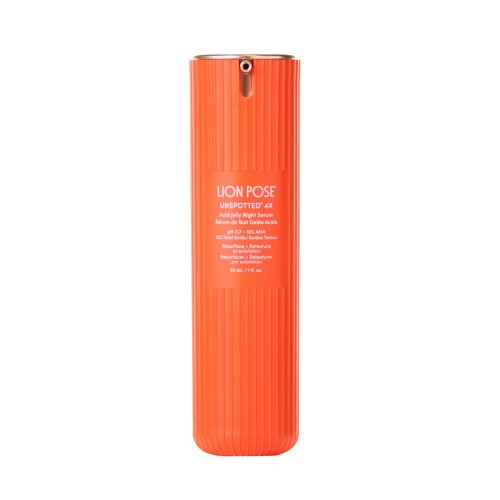
Lion Pose, UNSPOTTED 4X® Acid Jelly Night Serum — $79.00
As mentioned, there has been a notable lack of effective hyperpigmentation treatments for people with darker skin tones, which was top of mind in Lion Pose’s development. The brand is working to make discoloration care more inclusive and accessible by providing products that have been tested on a range of skin types, tones, and textures, and is backed by actor Mindy Kaling.
Its hero product, UNSPOTTED 4X Acid Jelly Night Serum ($79) pairs a 15 percent blend of azelaic, glycolic, lactic, and tranexamic acids with antioxidants like glutathione to lift away dead skin cells, improve the evenness of skin tones, and visibly reduce dark spots and acne scars. UNSPOTTED 4X was clinically tested on Fitzpatrick skin tones 2-6, and 97 percent of participants saw a reduction in dark spot size after eight weeks (and 93 percent saw results after only a month).
Melnick S, Lohani S, Alweis R. Hyperpigmentation in a middle aged woman: a common yet underdiagnosed condition. J Community Hosp Intern Med Perspect. 2016 Jul 6;6(3):31544. doi: 10.3402/jchimp.v6.31544. PMID: 27406454; PMCID: PMC4942510.
↩︎El-Kashlan N, Alexis A. Disparities in Dermatology: A Reflection. J Clin Aesthet Dermatol. 2022 Nov;15(11):27-29. PMID: 36381186; PMCID: PMC9651153.
↩︎
Sign up for the Well+Good SHOP Newsletter
Get exclusive deals on wellness, beauty, fitness, and food products that have been hand-picked by our editors.
Got it, you've been added to our email list.










